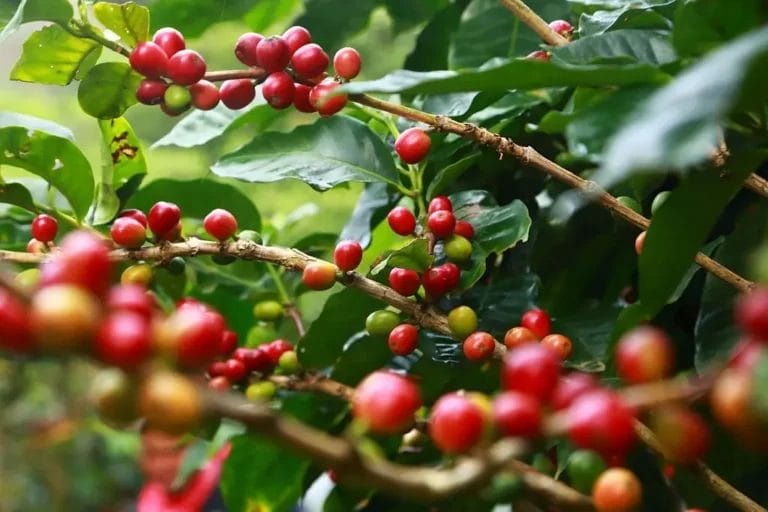Coffee is a little taste of heaven served in a cup extracted from a coffee bean. But, ever wondered what are coffee cherries and where it comes from? It comes from a beautiful bright red fruit called a coffee cherry that grows on a glorious plant called a coffee plant.
So, it is a cherry where all the magic resides. But what is inside of this magical fruit? What does it taste like? And what does the cherry bring to your cup? If you are curious for answers, follow us. But, first, Coffeenom will explain the coffee cherry inside out [Pun intended].

What Are Coffee Cherries?
The coffee cherry is the mother of the bean. It nourishes, protects, and helps the bean grow.
The coffee cherries are grape-like fruits that grow on coffee trees. The coffee tree starts blooming with self-pollination. The coffee flower both smells and looks lovely, like jasmine. The pleasant aroma attracts you to stay in that environment.
On an average coffee tree, It takes about nine months for the flowers to transform into coffee cherries. You may see them hanging in clusters along a tree branch in a coffee-growing region. The cherries are green as raw and turn bright red when ripened.
The bright red color indicates that they are ready to be harvested. The coffee beans that we roast and brew are the seeds found inside the fruit. Each cherry produces two beans that grow in pairs.
What Is Inside The Coffee Cherries?
Whenever we use the word “Anatomy,” an image of a bare skeleton and other gross things pop up in our minds. But this is not that kind of anatomy.

The outer layer or the skin of the coffee cherry is called “exocarp.” The coating can have yellow, orange, bright red, or even pink colors. But it all depends on the variety of the fruit.
Don’t confuse green cherries with green coffee beans, though. Green beans are the unroasted beans that still reside within the coffee fruit.
The coffee cherry has soft juicy flesh, called “mesocarp.” At the center of the pulp layer (mesocarp) hides the beans named “endosperm.” There is a slimy layer underneath the coffee pulp called mucilage. Beneath mucilage, there is a thin papery cover called parchment. These layers are full of sugar.
Inside of parchment, there’s another layer called silver skin, in which our precious beans are held. It acts to protect the bean. Hard outer skin covers the whole cherry. The outer skin protects the coffee seeds from insects and other external damage.
Sometimes, a coffee berry can contain only one bean. This phenomenon is known as a pear berry and is a rare occurrence. However, there is a 5% probability of a coffee being a pear berry. Therefore, you should keep pear berries separate to make sure your coffee roast and grind are consistent.
The parchment gets extracted when the first step of the dry milling process. But sometimes, the parchment is left intact and sold as a unique brand of coffee.
How Does The Coffee Cherry Anatomy Affect Your Cup?
Though there are different methods to get the impurities out of the beans, every other method affects the beans’ state differently, which affects the final taste of the cup in your hands after passing through the roasting process.
For example, in natural coffee, the fruit flesh is removed after drying, but in washed coffee, the fruit flesh is removed before the process starts.
In pulped or honey processing, only part of the mucilage and flesh is removed before drying, and the rest is removed afterward.
Leaving the mucilage on the beans gives it a sweeter taste with a higher body count (no, not that kind of body count). If you compare dry and wet processing, you can tell why dry-processed coffee is sweeter.
After picking the cherry-like fruit from a coffee tree, the beans germinate. The process stops right when the dry processing starts. Since natural coffees begin the drying process early, they contain more sugary goodness in the beans than washed coffee.
Though not sweet, washed coffee grounds have higher acidity. Contrary to this, natural coffees are more fruity and sweet.
During both dry and wet processing, the mucilage present in the coffee beans can start fermenting. If you are not careful, this unpredictable event can ruin the quality and taste of the roasted coffee beans.
Summary: Want beans with a sweet flavor? Leave the pulps and mucilage on.
Having fun Nomies? Check out our piece on types of coffee beans.
Can We Eat The Coffee Cherries?
Many coffee lovers frequently ask this question, and the answer is yes. Coffee cherries are perfectly safe and edible. But why aren’t coffee cherries as common as strawberries or mangoes?
The reason is that the juicy pulp part of the cherry is too small—the hard outer skin and the bean account for most of the fruit. So, biting the cherry gives you a little goodness among all the hardness.
What Do Coffee Cherries Taste Like?
We know that it’s edible, but what does a coffee cherry taste like?

A ripe coffee cherry has a lovely flavor. The cherry is sweet as honey. Some of them have the aromas of jasmine. And some taste like berries or even apricot mixed with a watermelon.
But there is a downside to the overall taste: the slimy texture.
What Do The Coffee Cherries Bring To Your cup?
The state of green coffee cherries determines the coffee bean quality. Skilled coffee farmers pick the fruits at their peak level of ripeness, while unripe coffee cherries get skipped.
That means that the fruit has a higher content of refined sugars. In turn, you will be able to enjoy the sweetness in your brewed cup.
The rest of the magic is added to the beans during their processing. Processing is the method for separating the beans from the skin, pulp, and mucilage.
Different processing methods affect the final cup’s tastes and flavor profiles differently. This happens because the anatomy of the coffee cherry is altered differently in each technique.
In the natural processing method, coffee farmers leave the pulp and mucilage on the bean during drying. So, the beans absorb sweetness from the coffee cherry pulp, which results in a fuller-bodied and sweeter cup of coffee.
While in the washed processing method, it is the other way round. So, the result is a clean, bright, acidic, and smooth coffee.
Honey processing is a combination of both. Some of the flesh gets removed, while the rest is left during drying. This process develops a flavor that resembles honey.
Coffee Cherry Juice
Coffee fruit is edible, but there is also cherry juice available in the market. A Hawaiian company came up with the idea of coffee cherry juice.
Since the cherries have a burst of nutrients, it offers plenty of health benefits. The drink gives you superpowers like stimulated brain function. The juice also has anti-inflammatory properties.
Another exciting way to enjoy the cherry drink is by powder form. The cherry powder is available in the market. Industrialists made this powder from the waste produced during coffee production. This powder gives an extra boost when added to any drink.
A Drink Made From Coffee Cherry Skin
I’m sure you have heard of cascara if you are keeping up with our posts. It is the coffee skins. Believe it or not, a drink made from these leftovers produced after gathering raw coffee beans is heavenly delicious. After peeling the skin off the pulp, it is cleaned and dried. The skin is then ready to be marketed.
If you’re not lucky enough to have sweet ripe coffee cherries taste, now’s your chance. A cascara drink will take you pretty close to it.
Coffee Or Tea?
Cascara drinks, like coffee cherry tea, or cascara latte, are considered between coffee and tea. This idea comes from the mix of them tasting like coffee, the level of caffeine present in the drinks, and the recipe of the drink resembling tea. Cascara tea or cascara syrup is made by diluting the cascara or coffee cherry shells in the water and then boiling them.
It’s a tea-like substance with the taste of coffee. Cascara tisane has been a well-renowned and popular drink in Yemen for quite a while since it’s a cheaper alternative to coffee due to its acceptable caffeine levels.
Benefits Of Coffee Cherries
Yes, these beautiful fruits of magical value have benefits. Who would’ve thought?
Here are a few benefits that coffee cherries contain
- Antioxidants in coffee cherries help you with skincare.
- Coffee cherry contents improve the health of your brain
- Coffee cherries give you a way to use all of it
Had fun reading? You’ll love to read our piece on french roast coffee.
Bottom Line
The coffee cherry comes from our favorite plant, the coffee plant. As a true coffee lover, it deserves your attention. So why not visit a coffee farm and try the cherries? Or its juice or even the cascara is there to enjoy.
FAQs
Yes, they are entirely safe to eat in a moderate amount. Coffee cherries are not only nutritious but also delicious. It has a sweet and juicy pulp.
There are plenty of health benefits of eating coffee cherries. It boosts our immunity and has antiviral and anti-inflammatory properties. In addition, it contains chlorogenic acid that relieves the body from radical damage. The high levels of antioxidants help to maintain healthy brain functioning. This also helps to lose extra fats from the body and reduce the risks of heart disease.
No, the taste of a cup of coffee is entirely distinct from a coffee cherry. The fruit is sweet as honey with the aromas of jasmine. The flavor may be reminiscent of berries or apricot mixed with a watermelon.
Yes. The taste of cherries determines how good the quality of the coffee bean will be—higher content of sugars in cherries results in more sweetness in your brewed cup.
The amount of caffeine present in the cherry varies. This is because many factors affect the caffeine content in the fruit. Such as the variety of coffee plant and the environment where it grows. Nevertheless, the caffeine content in cherries is much lower than that of coffee beans.
Yes, its natural antioxidants help to fight skin inflammations. Eating coffee cherries keeps skin healthy and lively. It has an anti-aging property that prevents wrinkles, fine lines, and cellular damage. In addition, you’ll observe sun damage and other apparent fine lines diminish slowly with time.
Yes, we can. The hard outer skin of coffee cherry was once discarded as garbage. Today we call the coffee cherry peels the cascara. These are now used for making valuable drinks. Believe it or not, a drink made from this leftover is heavenly delicious.

